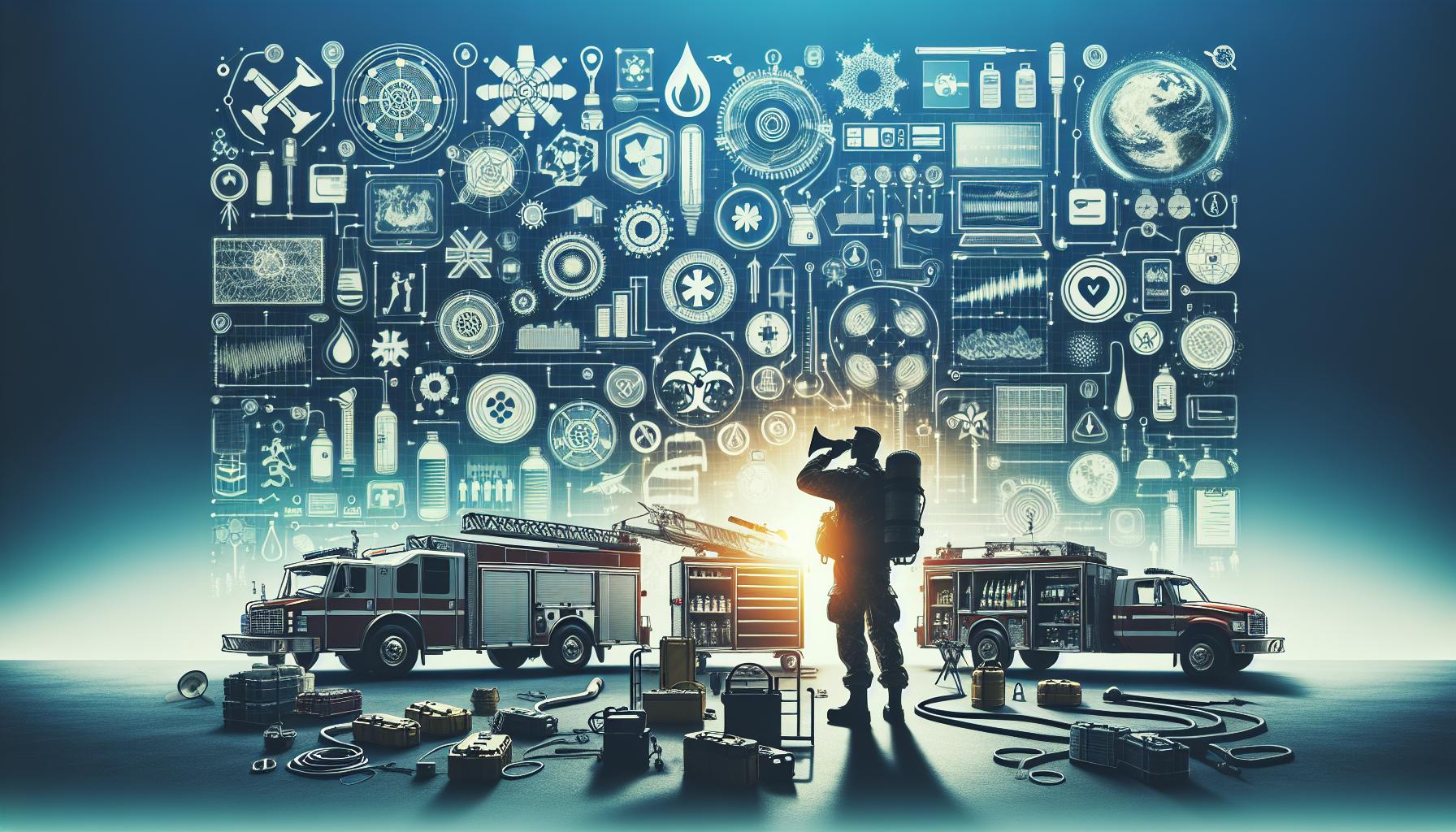Understanding the life cycle of hazardous materials is crucial for ensuring safety and environmental protection. Manny people overlook the phases these substances undergo, from production through disposal, frequently enough leading to risky mishandling. This article clarifies each stage, empowering readers to better appreciate their role in managing hazardous waste responsibly.
Understanding the Phases of Hazardous Materials Life cycle
Understanding the intricate journey of hazardous materials is crucial for ensuring safety and compliance in various industries. The life cycle of hazardous materials is not just a logistical concern; it directly impacts environmental health, regulatory adherence, and community safety. By grasping the phases of this life cycle, businesses and individuals can better manage risks and enhance their operational effectiveness.
Overview of hazardous Materials Life Cycle Phases
The hazardous materials life cycle consists of several critical phases that each play a vital role in risk management. These phases typically include:
- Acquisition: The first phase involves procuring hazardous materials while considering safety regulations and potential environmental impacts.
- Storage: Proper storage practices are essential to prevent accidental releases and ensure safe handling, in compliance with guidelines set by organizations such as NASA and the DOT.
- Usage: This phase encompasses the operational application of materials,requiring strict adherence to safety protocols to minimize exposure risks and reduce liability.
- Disposal: Proper disposal methods are crucial to mitigate environmental contamination and align with regulatory mandates.
Practical Considerations in Each Phase
Incorporating robust standard operating procedures (SOPs) at each phase of the hazardous materials life cycle can substantially reduce risks. For instance,during acquisition,regulatory frameworks outline strict guidelines to ensure that only compliant materials are purchased. An example is the requirement for documentation and risk assessments when sourcing chemicals that are known to be toxic or hazardous [2].
During the storage phase, it is vital to employ appropriate containment methods, such as using secondary containment systems and ensuring that storage facilities are equipped with the necessary safety equipment. This is in line with the protocols outlined in various regulatory documents, aimed at preventing leaks and spills [3].
The usage phase demands rigorous training for personnel involved in handling hazardous materials. Implementation of thorough training programs can enhance worker safety and improve compliance with OSHA standards. Regular drills and updates on safety procedures can definitely help mitigate incident risks.
In the disposal phase, organizations must follow established waste disposal regulations to avoid penalties and environmental harm. This may include using certified disposal facilities, maintaining documentation for waste transfer, and conducting audits to ensure compliance with federal and state regulations <a href="https://www.phmsa.dot.gov/sites/phmsa.dot.gov/files/docs/reportinginstructionsrev.pdf”>[1].
collectively, understanding and managing each phase of the hazardous materials life cycle allows organizations to operate safely and responsibly, supporting both regulatory compliance and environmental sustainability.
Identifying Hazardous materials: What You Need to Know
Identifying hazardous materials is crucial for ensuring safety in both workplace and environmental contexts. Every year, thousands of incidents occur due to improper handling of substances that can pose severe risks to health and safety. Understanding how to recognize these materials is the first step in mitigating hazards associated with their life cycle phases.
Essential Characteristics of Hazardous Materials
Hazardous materials are often categorized based on specific characteristics that indicate their potential dangers. These characteristics include but are not limited to:
- toxicity: Materials that can cause harm through ingestion, inhalation, or skin contact.
- Flammability: Substances that can easily ignite and sustain combustion.
- Reactivity: Chemicals that can react violently with air, water, or other substances.
- Corrosiveness: Agents that can cause severe damage to living tissues or materials upon contact.
Understanding these properties is vital for everyone involved in the handling and processing of perhaps hazardous materials. As an example, checking Safety Data Sheets (SDS) can provide detailed details about the chemical properties and necessary safety measures for specific substances.
Proper labeling and Storage
One of the most effective ways to identify hazardous materials is through proper labeling and storage practices. All containers that hold hazardous chemicals should be clearly labeled with appropriate hazard symbols and data regarding the nature of the material. OSHA regulations stipulate comprehensive labeling guidelines that help in identifying risks associated with chemicals in the workplace [2[2].
To further enhance safety, organizations should employ robust storage solutions that segregate incompatible materials and maintain the stability of hazardous substances. For example,flammable liquids should be stored in approved cabinets designed to contain spills and reduce fire risks.
Training and Awareness
Recognizing hazardous materials is not just about reading labels or understanding properties. It also involves comprehensive training and awareness programs for all employees handling such materials. Regular training helps workers stay informed about new hazards, safe handling practices, and emergency response protocols.
The following table summarizes key actions organizations should take to ensure hazardous materials are properly identified and handled:
| Action | Description |
|---|---|
| Conduct Risk Assessments | Evaluate potential hazards associated with materials in use. |
| Implement Labeling Standards | Ensure all hazardous materials are accurately labeled for easy identification. |
| Provide Comprehensive Training | Train employees on hazard recognition and safe handling practices. |
| Develop Emergency Response Plans | Prepare protocols for managing spills, exposure, or other incidents. |
Staying informed about identifying and managing hazardous materials is essential for workplace safety, environmental protection, and compliance with legal standards. following the guidelines and best practices from the hazardous materials life cycle phases can significantly reduce risks and promote a safer working environment for everyone involved.
The Role of Regulation in Hazardous Materials Management
Regulating the transportation and disposal of hazardous materials is not just a matter of compliance; it is indeed a critical aspect of protecting public health and the environment. The intricate nature of hazardous materials—ranging from chemicals in everyday products to industrial waste—necessitates a structured regulatory framework to manage risks effectively throughout their life cycle. As outlined in the comprehensive exploration of hazardous materials management, stringent regulations serve as the backbone for ensuring safety and accountability in the handling of these substances.
Understanding Regulatory Frameworks
Various regulatory bodies, such as the Department of Transportation (DOT) and the Environmental Protection Agency (EPA), play a vital role in shaping the landscape of hazardous materials management. The combination of federal, state, and local regulations creates a multilayered approach that addresses everything from the classification and labeling of hazardous materials to their packaging, transportation, and final disposal. This dynamic regulatory environment is essential for mitigating incidents that can arise during the lifecycle of hazardous materials, thereby minimizing potential exposure to humans and ecosystems.
- Compliance Requirements: Companies are mandated to follow comprehensive guidelines that stipulate how hazardous materials should be handled throughout their life cycle.
- Training & Certification: Employees must undergo training to ensure they understand how to manage hazardous materials safely and comply with applicable regulations.
- Emergency Response: Regulations require organizations to have emergency response plans in place, ensuring a rapid and effective reaction in case of accidents.
Real-World Applications of Regulations
To illustrate the importance of regulations in hazardous materials management, consider the impact of the Hazardous Materials Transportation Act. This pivotal legislation aims to establish a uniform regulatory structure for transporting hazardous materials across state lines, thus reducing the risk of spills and ensuring safe and efficient transportation methods. As an example, in the case of a chemical spill during transport, strict adherence to this act can make the difference between a contained incident and a widespread environmental disaster.
| Hazardous Material Type | Regulatory Body | Key Regulation |
|---|---|---|
| Chemicals | EPA | Resource Conservation and Recovery Act (RCRA) |
| Flammable Materials | DOT | Hazardous Materials Regulations (HMR) |
| Toxic Substances | OSHA | Hazard Dialog Standard |
Ultimately, the management of hazardous materials is a multi-faceted process grounded in robust regulations. These regulations not only strive to safeguard human health and the environment but also equip industries with clear guidelines to follow, thereby promoting safety and sustainability across all phases of the hazardous materials life cycle.Understanding and adhering to these regulatory frameworks is essential to foster a culture of safety and responsibility in hazardous materials management.
Safe Handling Practices: Protecting Yourself and the Environment
The improper management of hazardous materials can lead to severe consequences for both health and the environment. Understanding safe handling practices is crucial. Here are key strategies that can significantly reduce risks associated with hazardous materials throughout their life cycle phases.
Implementing a Comprehensive HazCom Programme
One of the foundational steps in safe handling is the growth of a robust Hazard Communication (HazCom) program. This program should address:
- Inventory Management: Keep an accurate inventory of all hazardous materials, ensuring they are identifiable and traceable.
- Labeling: Clearly label all hazardous materials with appropriate hazard symbols and handling instructions to facilitate safe use and storage.
- Training: Provide comprehensive training for all employees who handle hazardous materials to equip them with the necessary knowledge and skills to manage these substances safely.
These elements help create a workplace culture that prioritizes safety and compliance.
Risk Assessment and Mitigation
Conducting thorough risk assessments prior to handling or transporting hazardous materials is vital. This process involves identifying potential hazards and assessing risks associated with specific materials. To mitigate these risks,organizations should:
- Develop Safety Protocols: Establish clear protocols that dictate how hazardous materials should be handled,stored,and transported.
- Use personal Protective Equipment (PPE): Ensure that employees wear appropriate PPE, such as gloves, goggles, and respirators, to reduce exposure during operations.
- Implement Engineering Controls: Invest in fume hoods, proper ventilation, and spill containment systems to minimize exposure and environmental release.
These precautions not only protect workers but also prevent potential environmental hazards.
Proper Storage and Disposal
Correct storage and disposal are critical components in managing hazardous materials throughout their life cycles. Here are essential guidelines:
| storage Guidelines | Disposal Guidelines |
|---|---|
| Store materials in compatible containers; avoid mixing incompatible substances. | Follow local regulations for hazardous waste disposal; never dispose of hazardous materials in regular trash. |
| keep storage areas well-ventilated and easily accessible in case of emergencies. | document disposal processes for auditing and compliance purposes. |
By adhering to these storage and disposal practices, organizations can minimize leaks, spills, and other environmental impacts associated with hazardous materials.
Incorporating these safe handling practices not only ensures compliance with regulations but also fosters an environment of safety, making it an integral part of the hazardous materials life cycle phases.
Waste Disposal Methods: Navigating the Complexities
understanding the intricacies of waste disposal methods is crucial in managing hazardous materials safely and effectively. With hazardous waste production on the rise, the choices made during disposal can significantly impact both human health and the environment. Each method comes with its own set of advantages and limitations, making it essential to navigate these complexities responsibly.
Treatment techniques
Hazardous waste can be managed through a variety of treatment methods that aim to reduce its harmful effects. Common approaches include:
- Chemical Treatment: This involves processes such as ion exchange, precipitation, and oxidation, which transform hazardous substances into less harmful materials.
- Biological Treatment: Using microorganisms to break down organic pollutants, this method is notably effective for biodegradable waste.
- Thermal treatment: High-temperature techniques, such as incineration, destroy organic waste and reduce its volume significantly.
- physical Treatment: Techniques like filtration and sedimentation separate hazardous materials from nonhazardous waste, making them safer for disposal.
Storage and Disposal Options
Once treated, hazardous waste requires proper storage and disposal. Here are the primary disposal options:
- Landfilling: A common method where treated waste is safely contained in specially designed landfill sites.
- Incineration: While effective in reducing waste volume, this method requires carefully controlled conditions to minimize air pollution.
- Recycling and Recovery: Some hazardous materials can be recovered and reused, helping to conserve resources and minimize environmental harm.
| Disposal method | Advantages | Disadvantages |
|---|---|---|
| Landfilling | Cost-effective, suitable for large volumes | Potential for groundwater contamination |
| Incineration | Reduces waste volume, can generate energy | Emits pollutants if not properly managed |
| Recycling and Recovery | Conserves resources, reduces pollution | Limited to specific materials, costly processes |
By comprehensively understanding these disposal methods, stakeholders can make informed decisions that align with best practices discussed in the article on hazardous materials life cycle phases. Each method’s choice should reflect a careful consideration of environmental impacts, economic factors, and public health concerns, ultimately leading to safer and more enduring hazardous waste management.
Risk Assessment in Hazardous Materials Management
Understanding
Risk assessment is a critical component in the management of hazardous materials, influencing safety and compliance at every stage of the material’s life cycle. The effectiveness of such assessments hinges on understanding the specific hazards associated with materials, their quantities, and the environments in which they are handled. As an example, substances that may seem benign in small quantities can pose notable risks during transportation or storage. Therefore, thorough risk assessment helps to identify potential hazards and establish protocols to mitigate them.
To effectively manage the risks, organizations should implement a structured approach that includes:
- Hazard Identification: Recognizing substances that meet the DOT’s hazardous materials criteria is the first step in any assessment. This involves analyzing chemical properties and potential exposure scenarios.
- Risk evaluation: This stage involves determining the likelihood and consequences of incidents involving hazardous materials. Utilizing models and ancient data can aid in predicting outcomes.
- Control Measures: based on the identified risks, organizations should develop action plans that include engineering controls, administrative procedures, and personal protective equipment to minimize exposure.
- Monitoring and Review: Risk assessment is not a one-time task. Continuous monitoring of practices and regular reviews of policies ensure that organizations adapt to new threats and maintain compliance with regulations.
Implementing Effective Risk management Strategies
Organizations need to integrate risk assessment findings into their overall hazardous materials management plan. For example, companies can employ tiered training programs based on risk levels associated with different hazardous materials. Those handling highly toxic materials could receive specialized training that emphasizes emergency response, whereas workers dealing with less hazardous substances might focus on general safety practices.A table summarizing typical hazardous materials and their associated risks can also be useful in the training process:
| Hazardous Material | Associated Risks | Recommended Control Measures |
|---|---|---|
| Amines | Skin and respiratory irritation | Use of PPE, adequate ventilation |
| Chlorine | Respiratory distress, chemical burns | Proper storage, emergency response training |
| Hydrochloric Acid | Corrosive to skin and eyes | Use of acid-resistant equipment, spill containment plans |
Incorporating practical, actionable insights into the assessment process fosters a proactive safety culture within organizations. By engaging employees and utilizing their knowledge of daily operations, companies can enhance their risk management strategies, ensuring that hazardous materials are handled safely throughout their life cycle. This holistic approach aligns with the principles outlined in the ‘Hazardous Materials Life Cycle Phases Demystified,’ ultimately promoting a safer workplace for everyone involved.
Best Practices for Emergency Response and Contingency Planning
Engaging in the careful management of hazardous materials necessitates a robust framework for emergency response and contingency planning. Understanding potential risks associated with different phases of the hazardous materials life cycle enables organizations to not only comply with regulations but also protect employees, the environment, and the community at large.
Key components of Effective emergency Response
An effective emergency response plan is essential for organizations dealing with hazardous materials. Here are some best practices that companies should implement:
- Comprehensive Hazard Assessment: Conduct thorough assessments to identify potential hazards associated with materials throughout their life cycle.This assessment should encompass not just storage and handling but also transportation and disposal.
- Training and Education: Regularly train employees on emergency procedures and the specifics of the hazardous materials they work with. Utilize drills to enhance preparedness and ensure that everyone understands their role during an emergency.
- Clear Communication Channels: Establish well-defined communication protocols to ensure that information flows efficiently during an emergency. This includes notifying local emergency services and maintaining contact with all stakeholders.
Creating a Sustainable Contingency Plan
Developing a contingency plan is a proactive step that helps organizations prepare for unexpected incidents. Here are crucial elements to include:
- Contingency Scenarios: Create detailed scenarios for potential emergencies, such as spills or unexplained leaks. By simulating these situations, organizations can develop strategic responses that could minimize risks.
- Resource Allocation: Identify and allocate necessary resources—both human and material—before a crisis occurs. This includes ensuring that safety equipment is readily accessible and properly maintained.
- Continuous Improvement: Post-incident reviews are invaluable for improving future responses. After an emergency is handled, review what went well and what could be done better, and update plans accordingly.
Case Example: Implementing Best Practices
An example of successful implementation of best practices can be seen in companies that handle chemical production. As an example, a major manufacturer conducted regular training sessions that included both employees and local emergency services. When a minor spill occurred, the prepared response team quickly mitigated the situation with minimal environmental impact and no injuries, highlighting the effectiveness of their contingency planning efforts.
By demystifying the phases of hazardous materials life cycles and aligning emergency preparedness strategies, organizations can create resilient systems capable of addressing potential crises efficiently and effectively. Emphasizing training, communication, and continuous improvement allows companies to not only resolve incidents but also foster a culture of safety and environmental stewardship.
The Importance of Training and Education in Handling Hazardous Materials
The Critical Role of Training in Hazardous Materials Management
Ensuring safety in environments that handle hazardous materials is not just a regulatory requirement; it is indeed a moral imperative. Every year, thousands of incidents involving hazardous materials occur due to insufficient training. In many cases, these incidents could have been prevented with appropriate education and awareness.In the context of the Hazardous Materials Life Cycle Phases demystified, it becomes evident that training is essential at every phase—from production and transportation to storage and disposal.
Effective training programs should cover key aspects such as general awareness, specific handling procedures, and emergency response techniques. Employees who are well-trained in the characteristics and risks associated with hazardous materials are better equipped to make informed decisions, which can drastically reduce the chances of accidents. Furthermore, comprehensive training fosters a culture of safety within organizations, empowering employees to take responsibility for their own safety and that of their colleagues.
- Compliance and Liability: Proper training helps organizations comply with local, state, and federal regulations, reducing liabilities.
- Accident Prevention: Through education, workers learn to recognize potential hazards and take proactive measures to mitigate risks.
- Emergency Preparedness: Training increases readiness for potential incidents, equipping teams with the skills to respond effectively.
Practical Steps for Effective Training
To create an effective training program, organizations should consider the following actionable steps:
| Step | Description |
|---|---|
| assessment | Evaluate the specific hazardous materials handled and the associated risks. |
| Development | Create training materials that are relevant to the specific materials and procedures used in your facility. |
| Implementation | Conduct regular training sessions,including practical exercises for hands-on experience. |
| Evaluation | Assess the effectiveness of the training program through quizzes, simulations, and feedback. |
By investing in comprehensive training programs and continually updating them to reflect the latest regulations and best practices, organizations can significantly reduce the number of incidents related to hazardous materials, thus creating a safer workplace. The hazardous materials life cycle phases hinge on education and awareness; thus, prioritizing training is non-negotiable for any organization dealing with these substances.
Innovations in Hazardous Materials Management: What’s on the Horizon
Transforming Hazardous Materials Management with Technology
As we venture into a future increasingly shaped by technology, hazardous materials management is undergoing a significant transformation. With regulatory pressures and the need for environmental sustainability, innovations are emerging that enhance safety, efficiency, and compliance throughout the hazardous materials life cycle. The integration of advanced technologies stands at the forefront of this evolution, offering solutions that were once unfathomable.
One key innovation is the adoption of real-time sensor technologies, which can detect harmful substances, offering early warnings of leaks or spills. These advanced sensors, equipped with analytics capabilities, enable rapid response to hazardous incidents, mitigating potential damage to human health and the environment. Incorporating these systems not only protects workers and communities but also streamlines compliance with safety regulations, as outlined in the article “Hazardous Materials Life Cycle Phases Demystified.”
- Bioremediation Techniques: Utilizing microorganisms to decompose hazardous wastes transforms these materials into less toxic substances, providing a biological approach to waste management.
- Phytoremediation: This innovative method involves using plants to absorb contaminants from soil and water, effectively cleaning polluted sites in a natural, sustainable manner.
- Data-Driven Decision Making: Advanced analytics is transforming how organizations manage hazardous materials, allowing for data-driven decisions that optimize safety and efficiency.
Future Trends to Expect
Looking ahead, the future of hazardous materials management will likely feature increased automation and artificial intelligence (AI). These technologies promise to yield enhanced accuracy in managing hazardous materials and more proactive compliance monitoring.As an example, AI can analyze vast amounts of data to predict hazardous incidents before they occur, thus allowing companies to take preventive measures.
The shift towards greener technologies is also on the horizon.Many companies are exploring waste-to-energy technologies that convert hazardous materials into renewable energy, aligning industrial processes with environmental sustainability goals. Not only does this reduce waste but also provides a viable solution for energy generation, showcasing a cyclical approach to hazardous materials management.
Incorporating these innovations into the hazardous materials life cycle can significantly reduce risks and improve overall management efficiency. As industries adapt to these changes,organizations committed to sustainability and safety will lead the way in transforming how hazardous materials are handled,ultimately defining the new standard for effective hazardous materials management.
Frequently asked questions
What are the Hazardous Materials Life Cycle Phases Demystified?
The Hazardous Materials Life Cycle Phases consist of generation, transportation, treatment, storage, and disposal.Understanding these phases helps manage risks associated with hazardous materials effectively.
Each phase emphasizes the importance of safety and compliance. For instance, during the generation phase, facilities must categorize and manage hazardous waste properly to prevent accidents. Adequate treatment methods are essential to minimize environmental impacts, while proper disposal ensures compliance with regulations. To learn more about regulations, visit the Frog Environmental’s FAQ page.
How do I identify hazardous materials during the life cycle?
Identifying hazardous materials involves assessing their chemical properties, potential risks, and classification under regulations.This identification ensures safe handling throughout the life cycle.
Using tools like Safety Data Sheets (SDS) and regulatory databases helps pinpoint hazardous materials. Proper training for employees on identifying these substances is also critical for compliance and safety. Understanding these basics is part of the larger picture of Hazardous Materials Life Cycle Phases Demystified.
What regulations govern hazardous materials in each life cycle phase?
Regulations such as RCRA (Resource Conservation and Recovery Act) govern the management of hazardous waste throughout its life cycle,providing guidelines for handling,treatment,and disposal.
Each phase is subject to different regulations aimed at minimizing risks.For instance, transport regulations require specific labeling and documentation for safe movement.Understanding these legal frameworks is crucial to ensuring safe practices in the hazardous materials life cycle.
Can I recycle hazardous materials?
Yes, recycling hazardous materials is absolutely possible, but it frequently enough requires specialized processes to ensure safety and compliance with environmental regulations.
Recycling can reduce waste and resource consumption, but it must be handled correctly to prevent contamination. Facilities need to work with licensed operators who follow the regulatory guidelines to manage and recycle hazardous materials safely.This process is crucial in understanding the Hazardous Materials Life Cycle phases Demystified.
Why are training programs essential in hazardous materials management?
Training programs are essential as they equip employees with knowledge regarding safe handling,emergency response,and regulatory compliance related to hazardous materials.
Effective training can significantly reduce accidents and promote safety within a workplace. It also ensures that staff are familiar with the various phases of the life cycle, including identification, treatment, and disposal of hazardous materials.
What steps are involved in the disposal phase of hazardous materials?
The disposal phase of hazardous materials involves proper packaging, transportation to a designated facility, and following regulatory requirements for safe disposal.
It is crucial to use authorized disposal methods, such as incineration or secure landfill, to prevent environmental contamination. Understanding these steps is a vital part of the Hazardous Materials Life Cycle Phases Demystified, ensuring compliance and safety.
Concluding Remarks
Understanding the life cycle phases of hazardous materials is crucial for effective management and compliance. From generation and transportation to treatment and ultimate disposal, each stage plays a vital role in safeguarding both human health and the environment.By demystifying these phases, we empower industries and individuals alike to engage in responsible practices.
As we navigate the complexities of hazardous materials, it’s essential to recognize the importance of each phase—identifying the waste generated, adhering to strict regulations during transport, ensuring safe and sustainable treatment options, and ultimately, considering the long-term implications of disposal methods.
We encourage readers to delve deeper into the subject and explore additional resources on hazardous waste management. By staying informed and proactive,we can work towards a safer and more sustainable future. Join us in this ongoing journey of learning and implementing best practices in hazardous materials management.






